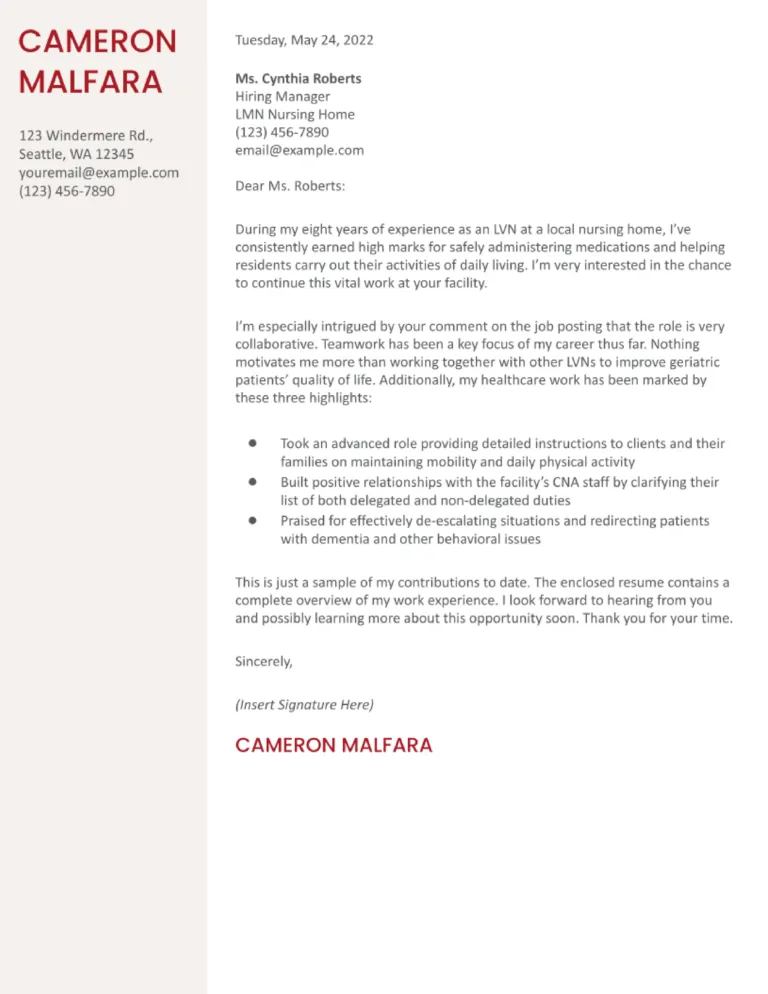Crafting the Perfect LVN Cover Letter
An LVN cover letter is your first chance to make a positive impression on a potential employer. It’s more than just a formality; it’s a crucial tool that allows you to showcase your skills, experience, and passion for nursing in a way that a resume alone cannot. A well-crafted cover letter can set you apart from other applicants, demonstrating your professionalism and genuine interest in the position. This guide will provide you with the secrets to creating an LVN cover letter that not only meets the requirements but also highlights your unique qualifications and helps you land your dream job. Remember that every detail matters when applying for a nursing position, and your cover letter is no exception. Invest the time and effort needed to create a compelling letter that grabs the reader’s attention and leaves a lasting impression. This document is not just an introduction; it is a representation of your dedication, attention to detail, and the value you can bring to a healthcare team. Therefore, it is important to ensure that your cover letter is error-free, well-organized, and tailored to the specific job you are applying for.
Understanding the Purpose of an LVN Cover Letter
The primary purpose of an LVN cover letter is to introduce yourself, express your interest in a specific position, and highlight the key qualifications and experiences that make you a suitable candidate. It serves as a bridge between your resume and the hiring manager, providing context and personality to your application. The letter allows you to demonstrate your understanding of the role, the organization, and the needs of the patients they serve. A cover letter should not simply repeat the information in your resume; instead, it should elaborate on your achievements, demonstrate how your skills align with the job requirements, and showcase your enthusiasm for the opportunity. A good cover letter helps you to distinguish yourself, to show off why you are a good fit for the company and the specific position, as well as the specific needs of their patients and healthcare facility. It also offers you a chance to showcase your personality and communication skills, further enhancing your chances of being selected for an interview.
Highlighting Your Qualifications
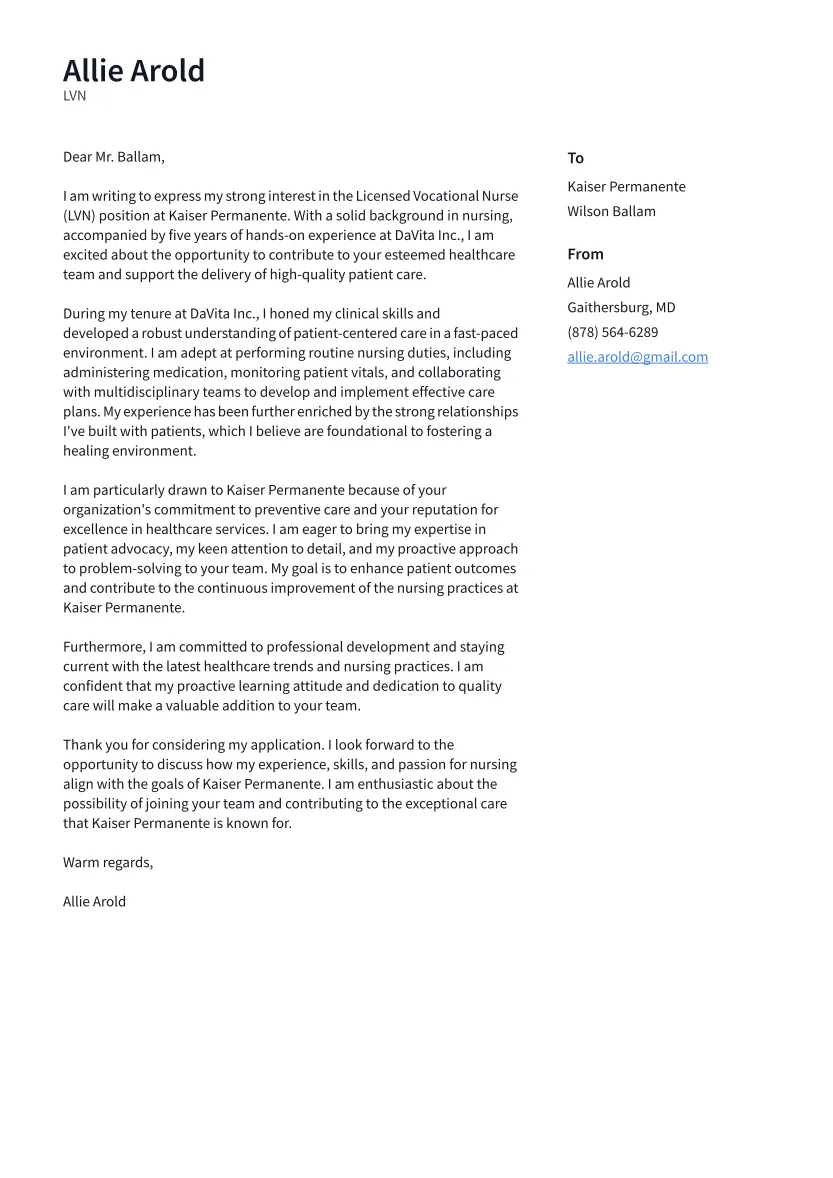
When highlighting your qualifications in your LVN cover letter, focus on the skills and experiences most relevant to the job description. Start by identifying the key requirements listed by the employer, such as specific certifications, technical skills, or patient care experience. Then, provide concrete examples of how you have demonstrated these skills in previous roles. Use action verbs to describe your accomplishments and avoid general statements. For example, instead of saying ‘I assisted patients,’ describe your actions with phrases like ‘Administered medications to patients, ensuring accuracy and safety.’ Be specific and provide quantifiable results whenever possible, such as ‘Reduced patient fall rates by 15% through implementation of safety protocols.’ Ensure that you showcase a balance of technical skills, such as medication administration and wound care, with soft skills, such as empathy, communication, and teamwork. Remember to tailor your letter to each job, emphasizing the qualifications that best match the employer’s needs and expectations. This will show your commitment to the role and give you a competitive edge.
Showcasing Your Skills and Experience
Your LVN cover letter is the perfect place to showcase your skills and experience in a compelling and engaging manner. Begin by clearly stating your relevant skills, such as patient assessment, medication administration, wound care, and vital sign monitoring. Back up your claims with specific examples from your work history, providing details about the tasks you performed, the patients you cared for, and the positive outcomes you achieved. Consider incorporating the STAR method (Situation, Task, Action, Result) to structure your examples effectively. Describe the situation you faced, the task you were assigned, the actions you took to address the issue, and the positive results you achieved. This approach helps the reader understand the context of your experience and the impact of your contributions. Also, highlight any experience you have with specific patient populations or healthcare settings, such as long-term care, acute care, or rehabilitation. Finally, remember to align your skills and experience with the requirements of the job description, ensuring your cover letter demonstrates you are the right candidate for the position. This approach will create a convincing narrative of your professional capabilities.
Key Elements of a Compelling LVN Cover Letter
Header and Contact Information
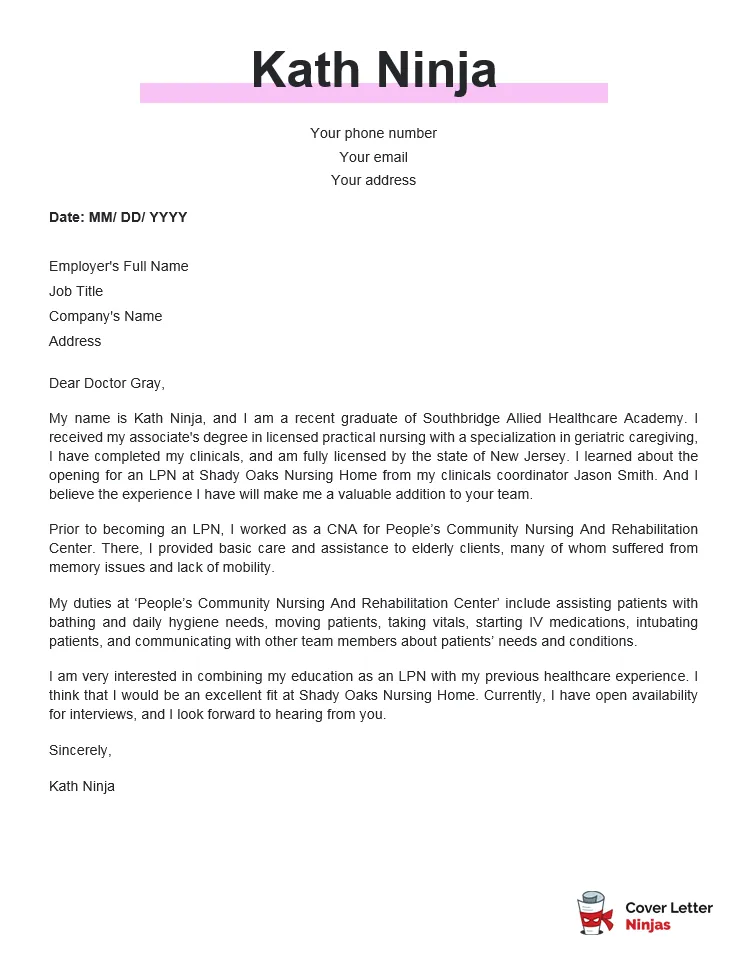
The header of your LVN cover letter should include your full name, address, phone number, and email address. Ensure this information is accurate and up-to-date, as this is how the hiring manager will contact you. Place your contact information at the top left or right of the page. Directly below your contact information, include the date, and then the hiring manager’s name (if known), title, and the healthcare facility’s name and address. If you are unsure of the hiring manager’s name, research the facility’s website or call the HR department to find this information. Addressing the letter to a specific person demonstrates that you have taken the initiative to learn more about the organization and the role. The header should be clean, professional, and easy to read. Proper formatting and a professional header establish a positive first impression and facilitate the hiring manager’s ability to contact you for an interview. Accuracy in this section is crucial, setting the foundation for the rest of your cover letter.
Professional Greeting
Begin your LVN cover letter with a professional greeting. If you know the hiring manager’s name, use ‘Dear Mr./Ms./Mx. [Last Name]’. This personalized approach demonstrates that you have taken the time to research the organization and the hiring process, immediately creating a positive impression. If you are unsure of the hiring manager’s name, a suitable alternative is ‘Dear Hiring Manager’ or ‘Dear [Department Name] Hiring Team’. Avoid generic greetings such as ‘To Whom It May Concern,’ which can appear impersonal. Your greeting should be followed by a brief introduction that clearly states the purpose of your letter – to express your interest in a specific LVN position. Immediately capture the reader’s attention by highlighting your enthusiasm and the specific role you are applying for. The greeting sets the tone for the rest of the letter, so it’s important to make it concise, professional, and tailored to the specific opportunity you are pursuing, increasing the likelihood of the hiring manager reading the rest of the letter with interest.
Body Paragraphs
The body paragraphs of your LVN cover letter are where you provide detailed information about your qualifications, skills, and experience. The body should be structured into two to three concise paragraphs. The first paragraph should mention the position you are applying for and how you learned about the opportunity. The second paragraph should highlight your most relevant skills, experiences, and accomplishments, providing specific examples to demonstrate your capabilities. Use action verbs and quantifiable results to showcase your impact in previous roles. The third paragraph should express your enthusiasm for the position and the healthcare facility. Explain why you are a good fit for the role and how your values align with the organization’s mission. Tailor each paragraph to the specific requirements of the job description, emphasizing the skills and experiences that match the employer’s needs. Maintain a professional tone throughout, using clear and concise language to convey your message effectively. The key is to tell a compelling story that highlights how you can bring value to the healthcare team, and show why you are the best candidate for the job.
Tailoring Your Letter to the Job
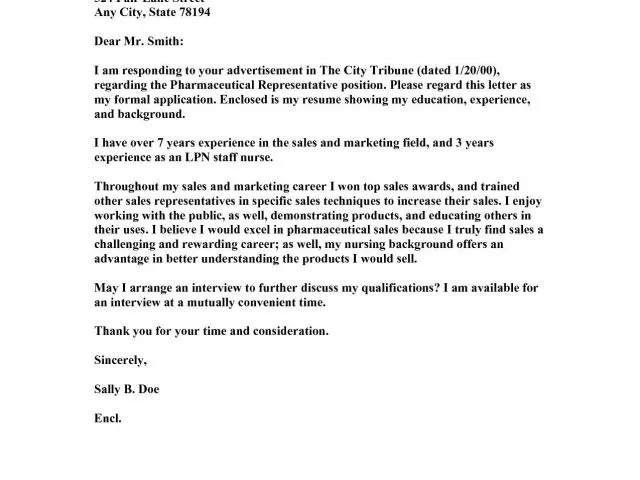
Tailoring your LVN cover letter to the specific job is essential for demonstrating your genuine interest and suitability for the role. Begin by carefully reviewing the job description and identifying the key requirements, skills, and qualifications the employer is seeking. Then, customize your cover letter to address these specific needs. Highlight the relevant experience and skills you possess, providing concrete examples of how you have successfully applied these skills in previous roles. Adjust your language and tone to align with the company culture and the specific demands of the position. If the job description emphasizes teamwork, for example, be sure to include examples of your collaborative skills. When showcasing your skills, consider using keywords from the job description to ensure your letter aligns with the employer’s expectations and the applicant tracking systems used by many healthcare organizations. Demonstrating that you’ve read the job description and understand what the employer is looking for increases the likelihood of your application being taken seriously, signaling your commitment to the opportunity and your attention to detail.
Quantifying Your Achievements
Quantifying your achievements in your LVN cover letter is an effective way to demonstrate your value and the positive impact you’ve made in previous roles. Instead of simply stating your responsibilities, use numbers and data to illustrate your accomplishments. For example, instead of saying ‘Improved patient satisfaction,’ state ‘Improved patient satisfaction scores by 15% through enhanced communication and patient care strategies.’ If you have experience with reducing medication errors, mention the percentage decrease you achieved. When describing your achievements, use metrics and statistics to provide a clear picture of your contributions. This could include the number of patients you cared for, the number of procedures you assisted with, or any improvements you made in efficiency or safety. Quantifiable achievements provide concrete evidence of your skills and abilities, showing the hiring manager how you can contribute to the organization’s success. They also make your cover letter more compelling and memorable, increasing your chances of getting an interview.
Demonstrating Your Passion for Nursing
Demonstrating your passion for nursing in your LVN cover letter is crucial for showcasing your genuine commitment to the profession. Begin by expressing your enthusiasm for the role and the opportunity to contribute to patient care. Share specific experiences that have fueled your passion for nursing. Examples may include particular patient interactions, personal experiences that drove you to pursue nursing, or challenging cases where you felt a strong sense of accomplishment. Describe the reasons that drive you to work in the nursing field. Mention the aspects of nursing you find most rewarding. This may be providing comfort to patients, helping them through difficult times, or working in a fast-paced environment. Emphasize your dedication to providing compassionate care, advocating for patients, and maintaining ethical standards. Conclude your cover letter with a clear statement of your interest in the position and your desire to contribute to the healthcare facility. The goal is to show the hiring manager that you are not only qualified but also genuinely excited about the opportunity, thus making a lasting impression.
The Importance of a Strong Closing
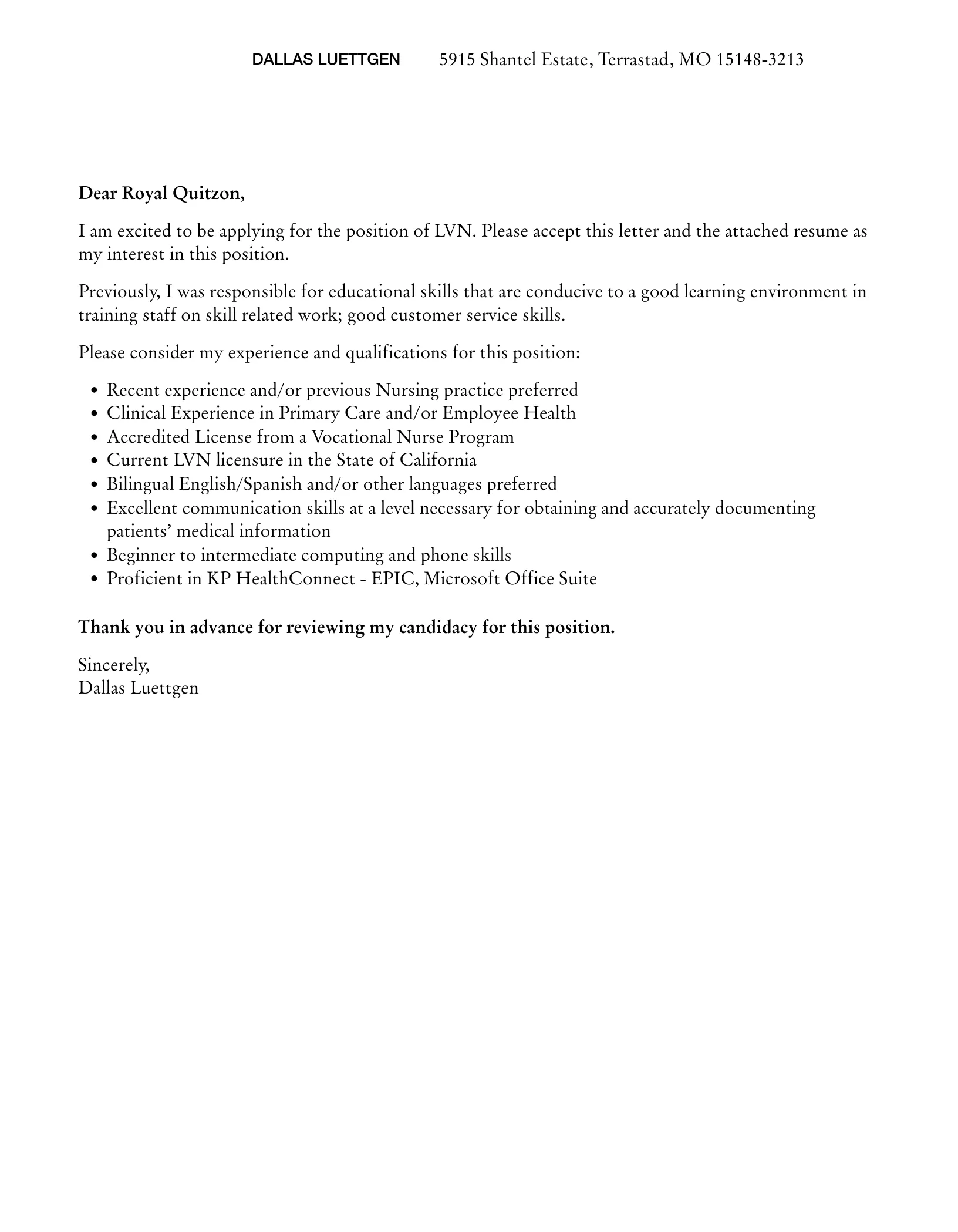
The closing of your LVN cover letter should be concise, professional, and memorable. Restate your interest in the position and the organization. Express your eagerness for an interview and thank the hiring manager for their time and consideration. Clearly state how you can be reached for an interview. Include your phone number and email address again. Avoid overly formal or generic closings. Instead, aim for a tone that reflects your personality and professionalism. For example, a suitable closing is ‘Thank you for considering my application. I am eager to discuss how my skills and experience can benefit your team. I am available for an interview at your earliest convenience and can be reached at [Phone Number] or [Email Address].’ A well-written closing reinforces your key message, leaves the reader with a positive impression, and encourages them to take the next step by contacting you. It also serves as a final opportunity to showcase your professionalism and enthusiasm. A strong closing can be a deciding factor in whether you secure an interview.
Proofreading and Formatting Your LVN Cover Letter
Ensuring Error-Free Writing
Proofreading your LVN cover letter is one of the most critical steps in the writing process. Errors in grammar, spelling, and punctuation can create a negative impression and undermine your credibility. To ensure your letter is error-free, start by carefully reviewing your work for any typos or mistakes. Use a grammar and spell-checking tool, but don’t rely on it entirely. These tools can miss subtle errors, such as incorrect word usage or sentence structure problems. Read your cover letter aloud to catch any awkward phrasing or unclear sentences. Ask a friend, colleague, or mentor to proofread your letter. Fresh eyes can often spot mistakes you might have missed. Pay special attention to names, dates, and contact information. Make sure they are correct and accurate. Proofreading meticulously demonstrates your attention to detail, professionalism, and commitment to quality. It can be the difference between being invited for an interview and having your application overlooked.
Choosing the Right Font and Format
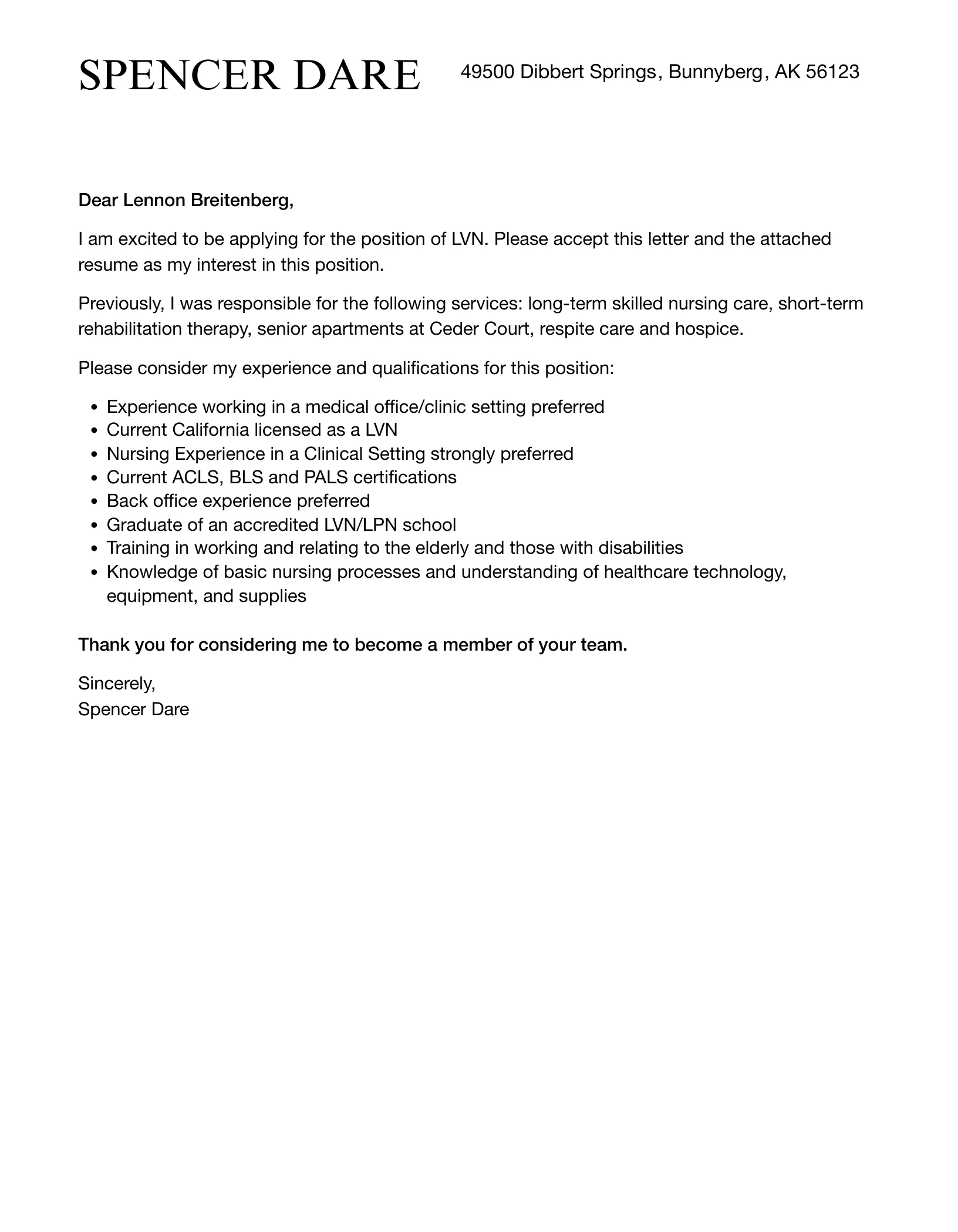
Selecting the right font and format for your LVN cover letter contributes to its overall professionalism and readability. Choose a standard, easy-to-read font such as Times New Roman, Arial, Calibri, or Helvetica. Keep the font size between 10 and 12 points for optimal readability. Use a single font throughout the entire document to maintain consistency. Set the margins to one inch on all sides. Use clear and concise spacing between paragraphs, and avoid dense blocks of text. Use bolding or italics sparingly to highlight important information, but avoid excessive use, as it can make your letter look cluttered. Left-align your text, and avoid justifying it unless you are creating a more formal document. Save your cover letter in a widely compatible format, such as .doc or .pdf. The .pdf format is generally preferred, as it preserves the formatting and ensures that your letter will look the same on any computer or device. A well-formatted cover letter is visually appealing and easy to read, making a positive first impression on the hiring manager.
LVN Cover Letter Examples and Templates
LVN cover letter examples and templates provide valuable guidance for writing your own letter. Use these resources to understand the typical structure, language, and style of a successful cover letter. Look for templates that match the specific job you are applying for and the healthcare setting. Review multiple examples to get ideas for different approaches and to see how other candidates have highlighted their skills and experience. Tailor the examples and templates to your specific background and the job description. Do not simply copy and paste; instead, use them as inspiration for crafting a unique and compelling cover letter that reflects your personality and qualifications. Examples and templates can help you structure your letter, provide ideas for content, and ensure that you include all the necessary information. They also help you to understand how to format your letter correctly and to use appropriate language. Many online resources and career websites offer free or paid LVN cover letter templates. Ensure that you modify the template to showcase your unique experiences, and always proofread your final version before submitting it.
